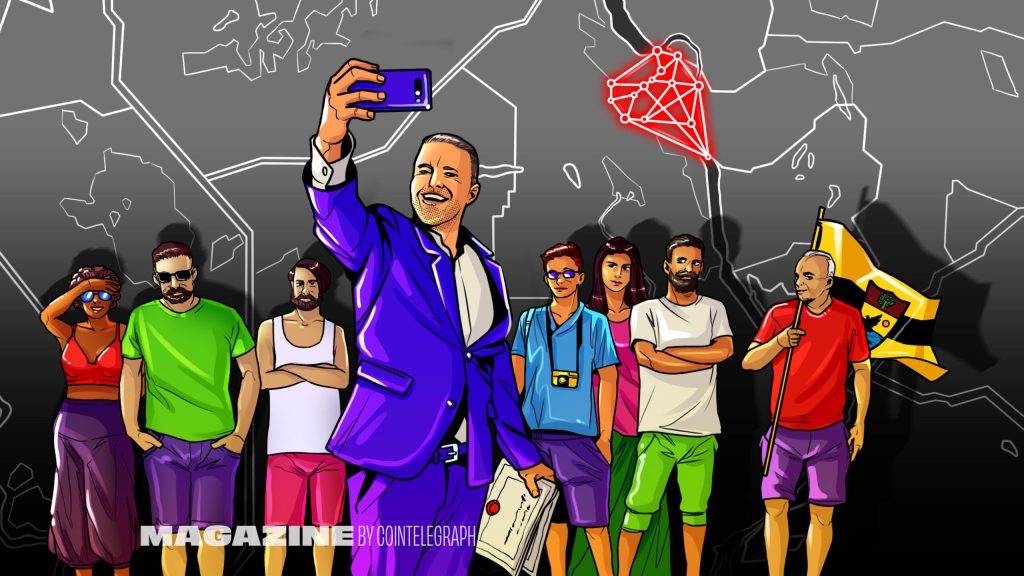Why are crypto fans obsessed with micronations and seasteading? – Cointelegraph Magazine

We can’t blame Elon Musk for dreaming of moving to Mars — the human race has always been curious about finding a better life somewhere else.
But not everyone in crypto is looking up to the stars to find new worlds; others stay on earth and attempt to build a new micronation, or a crypto community, here. There are dozens of projects in development — and a few actually operational — including Liberland, Satoshi Island and Puertopia/Sol attracting interest from the blockchain world.
Liberland
While many head out to sea to build their new communities, another option is to find land left over after conflicts. This is not as crazy as it sounds, and in the shifting territorial landscape after the breakup of the Yugoslavian empire, small pockets of land have turned up. Vít Jedlička, a Czech economist and Libertarian, founded Liberland on April 13, 2015 – on Thomas Jefferson’s birthday – on a small track of terra nullius (unclaimed land) on the banks of the Danube between Croatia and Serbia. At seven square kilometers, it is larger than Vatican City and Monaco and similar in size to Gibraltar.
The tiny nation is not yet habited despite boasting 785,000 citizens, all of whom currently reside abroad.
Jedlička wanted to form a new nation with low taxes and greater freedoms, and he found the land literally by Googling the term “terra nullius.”
“We had a need to start a new country in order to defend the personal and economic freedoms of certain groups of people that really enjoy freedom and want to live in a free society,” says Jedlička.
“Liberland is a pristine piece of land; it’s a beautiful place with sandy beaches, and I think it’s actually one of the most beautiful places on the Danube. People can actually come there for recreation, and people are coming camping there as we speak even though it’s winter right now.
“Of course, there are some major challenges, including geopolitical challenges that we have to overcome.”
Liberland is in phase one and preparing the groundwork for future recognition and urban development. So, nothing has yet been built, although you can sign up for residency online. The would-be country has signed memorandums of understanding with Ghana, Malawi and Haiti, and while official recognition has not been achieved, Jedlička is convinced it is only a matter of time.
The crypto angle
The government has selected the Polkadot ecosystem to develop the country’s governance and will rely on DAOs to run everything transparently.
“We will be running everything at the speed of light. Everything, including Congress, the land registry, the courts system and budgeting, will be registered on the blockchain. This will allow for all decisions to be transparent and to happen at speed. We are also planning for citizens to run the nodes on their IT infrastructure on their computers at home and to make money while supporting Liberland.”

There will be two houses of “parliament” in Liberland. The first is more meritocratic where citizens who hold the official Merit token, pay voluntary taxes and contribute to Liberland can vote on decisions in the country. The other house is the Senate and will be populated with people who helped build Liberland and will have more of an oversight role, including Jedlička moving into a steward position if he is voted out of his current position.
Voting will be frequent, every three months, to ensure that the citizens can actually influence decision-making rather than in traditional four-year election cycles. The code is in place and is scheduled to be launched on the eighth anniversary of the foundation of the state, April 13, 2023. In time, there will be a maximum of 14,000 active voters at any given time.
Liberland is being put together in the Arctic Village next door in Serbia, which is largely neutral to Liberland, while it seeks to improve its still uncomfortable relationship with Croatia.
Verdis next door
A neighboring strip of land was also claimed by a passionate founder — this time, by 14-year-old Daniel Jackson in 2019, who wishes to establish Verdis. Jackson was born and raised in Australia to English parents, and the now 18-year-old does not see his age as an impediment.
“A group of people and I decided to create Verdis in order to help make a difference in the world, especially around reconciliation of ethnic groups, neutrality zone, a new government structure, and a way to hopefully help boost tourism and economy in Slavonia and Vojvodina as an extra benefit for neighboring Croatia and Serbia,” says Jackson.

Verdis is roughly 0.451 square kilometers, making it slightly larger than Vatican City.
“In some ways, I did see inspiration from Liberland, but we still have different goals and aspirations. I think that with enough effort and hard work, Verdis is feasible, especially with our right to the land under international law.”
Around 27 people are currently involved in Verdis’ government. The nation is in the process of having its passports recognized by the Chief Immigration Officer of Eswatini (formerly Swaziland).
According to Jackon, most of Verdis’ citizens plan to move to Verdis in the future, starting with houseboats along the Danube.
“We believe Verdis will survive, as long as it is actively worked on, and works to keep its voice loud in its search for international recognition,” says the young acting president.
Satoshi Island
Satoshi Island was founded in 2021 by acquiring an entire island in the South Pacific Ocean. Aimed at digital professionals and based 100% on cryptocurrencies, the island looks to attract tech professionals looking to work alongside like-minded people.
The vision behind Satoshi Island was born out of a feeling of wishing that industry-based events and conferences would last longer. Online is fine — but even better is to have a year-round venue where crypto enthusiasts and professionals could live, work and visit.
Unlike some of the other projects, Satoshi Island is simply about celebrating crypto, and the island venue was simply to give it a sense of freedom and community.

“The Satoshi Island project has no political agenda, separatist or ideological ideas,” a spokesperson tells Magazine. “Whereas some people might think that the vision stems from wanting to escape due to being disenfranchised with the rest of the world, this couldn’t be further from the truth. The only goal is to create a place for people in the industry to congregate and have the ability to utilize blockchain technology to the fullest. The island could be most likely compared to a private retreat or golf course where only members can visit.”
Starting with a blank slate allowed them to look at the master planning of the island with fresh ideas. All the systems (where possible) will be blockchain-based and sustainable, with everything 100% powered by renewable energy generated on the island. Modular development is also an important aspect of the island. This type of architecture allows them to build in ways that significantly reduce the time, disturbance and impact on the nature and landscape.
The rep tells us that families with children seem to be attracted to the idea, “often with the female being the main proponent.”
“We are expecting the population to be a mix of people living and working on the island all year round, as well as people who live there half the year as they escape colder or hotter climates.”
You can also take a holiday there. Take a look at the interesting Satoshi Island video here.
Puertopia, I mean, Sol
Puerto Rico was another hot spot for crypto bros. People such as Brock Pierce of EOS and Tether fame and Joel Comm of the Bad Crypto Podcast relocated to the U.S. territory where taxes are favorable and the crypto rich were welcomed, at least initially by locals enjoying income growth, especially in hospitality. There were grand plans to build a blockchain-powered city called Puertopia in the derelict remains of the Roosevelt Roads Naval Base in Ceiba, which would include a crypto-exclusive bank and showcase “what a crypto future could look like.” The New York Times reported that someone told it Puertopia translates to “eternal boy playground” (which sounds suspiciously like a joke directed at Pierce), so they changed the name to Sol. A backlash against crypto and the effects of crypto winter in 2022 has seen updates on the project dry up of late.
Crypto Utopia
Kyle Chase of Master Ventures fame and crypto influencer attempted to set up a Libertarian crypto community and business incubator in his beloved Thailand. Magazine paid a visit in February last year and heard wild tales of “unchecked merrymaking,” crypto-influencers, police grillings, a reported $20,000-a-month burn rate and a collision between idealism and reality. After shifting locations a number of times, the concept has yet to be fully realized.
MS Satoshi
The project that was the Satoshi Cruise ship suffered an ignominious ending — through red tape rather than political inference. Launched by three cryptocurrency advocates in 2020 when cruise ships were relatively cheap as a result of the pandemic, the ill-fated Satoshi Cruise Ship failed to ignite real interest in Libertarians interested in making it their home.

Attempts were made to sell off rooms, but limits on cooking and general living on a cruise ship did little to attract citizens, and then the enormous running costs and regulations around running and maintaining a ship (even down to permits and sewage) proved too much for the founders. It has now been converted back into a luxury cruising vessel.
Seasteading

Seasteading refers to the idea of building permanent homes on the sea, known as seasteads, in areas that are not under the jurisdiction of any government.
At present no one has actually created a seastead that has been officially recognized as a sovereign state. Different designs for seasteads have been proposed, such as modified cruise ships, repurposed oil rigs and specially constructed floating islands. It is fraught with legal difficulties, however, as a Bitcoiner couple who set up a floating home off the coast of Thailand discovered when the navy hauled them and charged them with violating Thai sovereignty.
The concept itself has been around for decades. The 2020 Netflix film Rose Island highlighted the attempt by Italian engineer Giorgio Rosa to build a sovereign island in the Adriatic Sea back in the 1960s, complete with a restaurant, bar, souvenir shop and post office. The short-lived experiment ended when Italian warships accosted the platform, removed the last inhabitants and then completely removed all evidence from the sea.
California-based nonprofit the Seasteading Institute was founded in 2008 by activist, software engineer and political economic theorist Patri Friedman, grandson of Nobel Prize-winning economist Milton Friedman.
Development director Carly Jackson tells Magazine she is currently aware of 12 seasteading projects in various stages of development (see the full list here), of which the leading ones are Arktide, Atlas Island, Atlantis Sea Colony and Freedom Haven.
The genesis of some of the projects is based on politics, including Atlas Island and Freedom Haven. Other projects, such as Arktide, a project that bought property in Puerto Rico as a base to build from, have incorporated blockchain from the very beginning.
“I expect one or more of the active projects to launch platforms in the next year or so. It will probably take a few more years to have enough of a community to move out to international waters. I’m not sure if that will make seasteading mainstream, but I hope it will be normalized for people to consider living on a floating city in a decade or so.”
The Maldives Floating City
The Floating City is scheduled to begin construction this year and has 5,000 housing units linked by waterways and laid out in hexagonal segments. The city boasts that it is a climate change solution, but with each house priced at $250,000, it appears to want to attract investors or nomadic professionals looking for somewhere to lay their hats.
Oceanix Busan
Oceanix Busan is planned to be located just one mile from the southeastern coast of South Korea. Initially, the project will consist of three triangular platforms, each capable of accommodating 12,000 people. The goal is for the project to expand into a hexagonal city of more than 20 platforms. The project (officially named Oceanix City) was presented by Bjarke Ingels Group and Samsung Group at the United Nations Roundtable of Sustainable Floating Cities in 2019, and it was agreed by the U.N. that it will be a prototype for sustainable floating cities. In addition to being a floating city, it will also serve as a testing ground for various sustainable living technologies.
The prototype of the floating city is due for completion this year and will comprise interconnected platforms that have a total surface area of 15.5 acres. Each modular piece of the city, which floats on water, is specifically designed for a particular purpose such as residential space, research facilities or accommodation.

For details on other micronations – click here.













